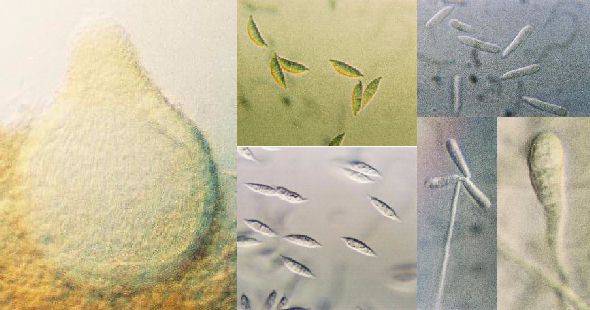
e Fig-1. Hypomyces corticiicola
Hypomyces corticiicola K. Poldmaa, Mycologia, 91: 185, 1999.
Anamorph:
Cladobotryum sp.
|
Hypomyces corticiicola K. Poldmaa, Mycologia, 91: 185, 1999. Anamorph: Cladobotryum sp. Teleomorph in nature Subiculum on the host are yellow (Munsell 5Y8/8, Methuen 3A6) to grayish yellow (Munsell 5Y8/6, Methuen 3B5), covering a part or entire surface of hymenium, parenchymatous, KOH(-); hyphae are 2.5-5.5 μm wide, septate, thick-walled. Perithecia are grayish yellow (Munsell 5Y8/2, Methuen 3C3) to straw yellow (Munsell 5Y8/3, Methuen 3B4), pyriform, embedded half immersed in the subiculum laer, (152-)165-200(-205) x (151-)165-200(-210) μm; papilla conical, (52-)65-70(-100) x 70-85(-105) mm, with flat upper surface, having an apical pore of (40-)45-60 μm; KOH(-) to turning to pale yellow (Munsell 5Y9/2, Methuen 3A3); perithecial walls are composed of several layers of angular cells of 5-8 x 5.5-11 μm, 8-10 mm thick; walls of beaks consist of long ellipsoidal to ellipsoidal cells of 3-5 x 5-8 μm, 8-32 mm thick, with inner peripheral hairs. Asci are cylindrical, (85-)109-117(-147) x (4.5-)5-5.5(-6.5) μm, 8-spored, bearing a basal stalk of 5-11(19) μm, with a slightly thickened apex, having an apical pore of 2-4.5 μm in diam. Ascospores are hyaline, fusiform, aseptate or 1-septate in the center, (17-)17.5-21(-22.5) x (4.5-)5-5.5(-6) μm, with prominent warts of 0.5 mm in diam., rounded at both ends with apiculi of (0.5-)1.5-3 μm in length. Characteristics in culture Colonies on MEA, OA or PDA grow rapidly and vigorously at 25°C, floccose up to 3-10 mm in height, white to pale yellow (Munsell 5Y9/2, Methuen 3A3) or grayish orange (Munsell 10YR8/4, Methuen 5B4), margins uneven; substrate hyphae are tangled to form vivid yellow (Munsell 5Y8/10, Methuen 3A8) or straw yellow (Munsell 5Y8/4, Methuen 3B4) sclerotia, in which perithecia and chlamydospores are born; odorless; the reverse are yellow brown (Munsell 10YR6/8-10, Methuen 5C-D8) or grayish orange (Munsell 10YR8/4, Methuen 5B4). Hyphae are hyaline, septate, thick-walled, (2.5-)5-11 μm in width. Conidiophores are born on the aerial hyphae, semi-macronematous, septate, slightly thick-walled, irregularly branched several times, (3-)5-5.5 μm wide, forming conidiogenous cells apically or laterally. Conidiogenous cells are born solitary or more often in a verticil of 3-4 on the conidiophores, hyaline, (55-)160-200(-460) x (3-)5-5.5 μm, slightly lanceolate tapering into one to several apical conidium forming loci, 1.5-3 mm wide. Conidia are born soiltary or in imbricate chains on the apex of conidiogenous cells, hyaline, 0-2(-3) septate, cylindrical to long ellipsoidal, thin-walled, smooth, (16-)25.5-27(-35) x (4-)5-6.5(-8) μm. Chlamydospores are formed laterally on the substrate hyphae, or born terminally in chain on the branches, brownish orange (Munsell 10YR7/4, Methuen 5C4), smooth, subglobose to broadly ellipsoidal, (11-)13-14.5(-16) μm wide.
Habitat: on polypores Known distribution: Germany, Estonia, and Japan Specimen examined: on Daedaleopsis styracina (P. Henn. & Shirai) Imazeki, collected in Noyamakita Part, Musashi-Murayama, Tokyo, Japan, on May 23, 2001, by Kiyoshi Iguchi (specimen: KPM-NC0009258; culture KS01009 = TAMA F 3237)
|
Top